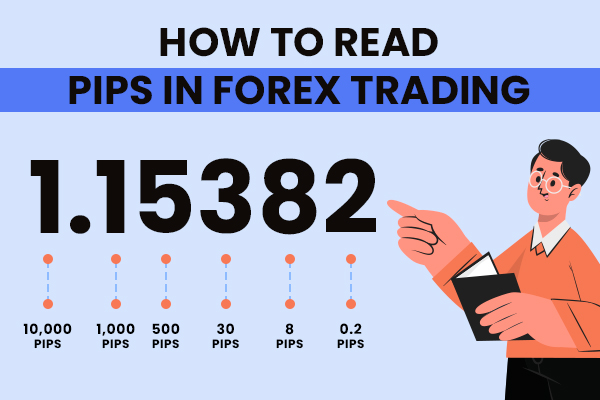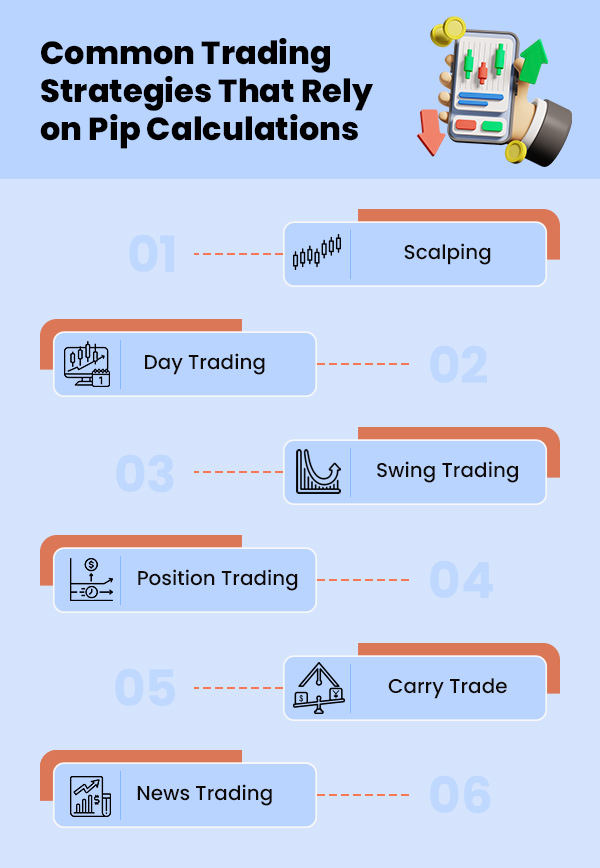| Getting your Trinity Audio player ready... |
Just a few years ago, only a few people were aware of forex trading, but due to digitalization, it has become a common topic of discussion in recent years among common people and those doing investments in the forex market.
Therefore, it has become important for them to understand forex trading basics and market terminologies. One such term is “pip,” the most frequently used word by forex traders in everyday conversations.
So, traders must understand what pips are and how it works. What is its importance?
Let’s dive in!
What are Pips?
“Pips” is a word folks use a lot in finance trading, especially in forex. It means the slightest movement in the price of a currency pair. Pips are super important because they show how much the value between two currencies changes.
In forex, traders need to keep a close eye on really small changes in currency trading. We’re talking about really tiny changes, like a hundredth or even a thousandth of a cent. Pips are just the way traders chat about and measure these super-small price changes in the forex market.
Also Read: How To Forex Trade In India: A Guide For Novices
Historical context and origin of the term “pip”
In 1797, the term “pip” originally referred to the seed of an apple or orange. It’s thought to come from the Old French word “pepin,” which dates back to the 13th century. This French term likely originated from the root word “pipp,” which conveyed the idea of smallness. Similar words like Italian “pippolo” and Spanish “pepita” also refer to seeds or kernels, supporting this idea.
In European countries, forex traders started using this term back in the 1970s so newcomers can easily understand it. It stands for “Percentage in Point” or “Price Interest Point.” People came up with it to describe the smallest price change in currency pairs accurately.
How Does a Pip Work?
In forex trading, currencies are typically quoted to four decimal places. The pip is the fourth decimal place for most currency pairs, except for pairs involving the Japanese yen, where it’s the second decimal place.
- Most currency pairs are quoted to four decimal places. In these pairs, the pip is represented by the fourth decimal place. So, if the EUR/USD pair moves from 1.2500 to 1.2501, one pip has moved.
- The pip is indicated by the second decimal place while trading currency pairs using the Japanese yen (JPY). That’s because the yen isn’t as valuable as other currencies.
So, even a small alteration in the second decimal place might significantly impact. For example, if the USD/JPY pair moves from 110.50 to 110.51, it will move one pip.

Pips are extremely essential since they represent the smallest price movement that determines whether you make a profit or a loss in a trade. Traders use pips to calculate how much they might make or lose, as well as when to establish stop-loss and take-profit limits. For accurate profit and loss tracking, traders can use a free profit and loss template, which helps in keeping a detailed record of gains and losses in forex trading.
Understanding pips is really basic for forex traders. They’re crucial for looking at price changes, deciding how much to trade, and managing the risks involved.
Also Read: What Is VPS In Forex? A Comprehensive Guide For Traders
Pipettes Vs Pip – Role in Modern Trading Platforms
In contemporary trading, the terms “pips” and “pipettes” are frequently used. Here is the difference between these two terms:
Pip
- The smallest possible price change for a currency pair is called a pip.
- It is the fourth decimal position for the majority of couples. However, it’s the second for couples that have the Japanese yen.
Pipette
- A pipette is a fraction of a pip.
- It’s used to measure even smaller price movements, especially when the exchange rate moves by a very small amount.
- A pipette is represented by the fifth decimal place in currency pairs that quote prices to five decimal places.
- For example, if the EUR/USD pair moves from 1.25000 to 1.25001, one pipette has moved.
Role in Modern Trading Platforms
Nowadays, trading platforms often show prices with five numbers after the decimal point to give traders more exact info. This helps traders spot even tinier price changes and make smarter trading choices.
In this setup, pipettes are key. They give even more precise details about price movements. This is super helpful for traders who do quick trading, where even tiny price moves can affect how much money they make or lose.
A lot of trading platforms let traders set rules about pipettes, giving them more say in how they trade.
Also Read: Types Of Business Models Startups Should Know
How to Calculate the Monetary Value of a Pip?
Figuring out how much money a pip is worth depends on a few things: which currencies you’re trading, how big your trade is, and what currency your trading account uses.
Here’s a simple formula:
Money from a Pip = (Value of a Pip) x (How much you’re trading)
For most currency pairs, you find the value of a pip like this:
Value of a Pip = (Pip in decimals) x (Trade Size) x (Pip Spot)
Let’s do an example:
Say you’re trading EUR/USD with a USD account, and you’re trading one standard lot (100,000 units).
Value of a Pip = (0.0001) x (100,000) x (1) = $10
So, if the EUR/USD pair moves one pip, you’d make or lose $10 with one standard lot.
Knowing how to figure out the money from a pip is important for handling risk well and making good trading choices. Just remember, the exact value of a pip can change depending on your account currency, trade size, and where the pip is.
Importance of Understanding Pip Values for Risk Management
Understanding pip values is super important in forex trading. Here’s why:
- Figuring Out Position Size: Pip values help traders decide how much to trade based on their risk and account size.
- Setting Stop Loss and Take Profit: Knowing pip values helps traders set these orders at the right levels to minimize risk.
- Calculating Risk vs. Reward: Pip values help traders see if potential profits make sense compared to the risk.
- Adjusting for Volatility: Different currency pairs move differently, so knowing pip values helps traders manage risk accordingly.
- Considering Trade Costs: Pip values help traders factor in expenses like spreads and commissions, making sure they plan for all the costs.
Explanation of How Leverage Affects Pip Value
In forex trading, leverage (which is the use of borrowed money to invest) matters since it can impact the amount of money you make with each pip. With less money, dealers may manage bigger trades thanks to it. To maximize your potential returns, you take out a loan from a broker.
How much control you have over what you put in is indicated by the ratio, which can be stated as 50:1 or 100:1.
- Bigger deals with Leverage: Leverage allows you to open deals significantly larger than your starting capital. For example, with 100:1 leverage, $1,000 in your account can control a $100,000 trade.
- How Leverage Hits Pip Value: It makes gains and losses in trades look bigger. Since pips show the tiniest price moves, leverage also changes how much each pip is worth.
- More Leverage, More Pip Money: Higher leverage means each pip is worth more cash. That means you could make or lose more for every little move in the market. Lower leverage, on the flip side, means less cash for each pip.
- Playing Safe with Risk Management: Leverage can bring in bigger profits, but it also cranks up the risk. More leverage means you could lose all your cash faster if the trade tanks. So, you’ve got to be smart with leverage and set stop-loss orders to keep losses in check.
Risks and Rewards of Using High Leverage in Forex Trading
Using a ton of borrowed money in forex trading can have good and bad sides. Let’s check them out:
★ Rewards
- Making big profits: Borrowing a bunch of money means even small price changes can make you rich.
- More chances to trade: With lots of borrowed money, you can grab more trading opportunities, especially when things are moving fast.
- Using money wisely: Borrowing money can help you make more money compared to not borrowing any.
- More freedom: Borrowing lots of money gives you more flexibility. You can spread your money across more trades or jump on quick chances without needing a lot of cash upfront.
★ Risks
- Big losses: Just like you can make big profits, you can also lose a lot of money if things go bad, even from small price drops.
- Unpredictable market: Borrowing a lot can make things really uncertain. Sudden changes in the market can wipe out your money if you’re not careful.
- Margin calls and losing everything: If you borrow a lot and your account balance gets too low, your broker might force you to add more money. If you can’t, they could close your trades, and you might lose everything.
- Stress: Trading with a lot of borrowed money can be super stressful. You might make bad decisions because you’re scared or greedy, especially when things are chaotic.
- Too much trading: Borrowing a lot might make you want to trade too often. But trading too much can lead to big losses and mess up your plan.
Common Trading Strategies That Rely on Pip Calculations
Forex trading involves tracking currency price movements, often using ‘pips’ as the smallest price increments. Different trading strategies rely on these pip calculations for decision-making.
Let’s explore a few of these strategies:

➢ Scalping
Traders make lots of quick trades to catch small price changes. They aim to make profits from small price moves, often just a few pips at a time.
➢ Day Trading
Traders buy and sell within the same day, trying to profit from short-term price changes. Pip calculations help them set profit goals and decide when to cut losses.
➢ Swing Trading
Traders hold onto positions for a few days or weeks to catch bigger price swings. Pip calculations help them spot entry and exit points for trades.
➢ Position Trading
Traders keep positions open for a long time, maybe months or even years, aiming to profit from big market moves. Pip calculations help them set profit targets and decide when to exit a trade.
➢ Carry Trade
Traders borrow money in a low-interest currency and invest it in a high-interest one. Pip calculations help them see potential profits or losses from currency price changes.
➢ News Trading
Traders jump into the market when big news comes out, trying to profit from the resulting price swings. Pip calculations help them decide when to enter or exit trades based on the news impact.
Impact of Forex VPS on Trading Pips
Forex VPS hosting can positively impact the pip in Forex trading by providing a more stable and reliable trading environment.
Here’s how:
- Reduced Latency: VPS servers are typically located close to major financial hubs, reducing the time it takes to execute trades. Lower latency can lead to faster trade executions, which is crucial for capturing small price movements measured in pips.
- 24/7 Operation: A VPS runs continuously, ensuring your trading platform is always active, even if your local device is turned off. This helps in executing trades based on automated strategies or during volatile market conditions, which can directly affect pip values.
- Stability and Reliability: VPS services offer high levels of uptime and are less likely to suffer from power outages or connectivity issues compared to home internet connections. This stability ensures that your trades are executed consistently without unexpected interruptions, leading to more precise pip management.
- Optimized Performance: A VPS can be optimized specifically for Forex trading, providing a dedicated environment with minimal resource contention, leading to more efficient trade executions and potentially better pip outcomes.
Overall, using a Forex VPS can enhance the efficiency and reliability of trade executions, directly impacting the accuracy and profitability of trades measured in pips.
Conclusion
Forex trading is becoming increasingly popular due to its ease of access online. That means that common people and investors should understand some fundamental concepts, such as pips. Pips are minor variations in currency prices that are extremely significant for effective trading.
Understanding them will allow you to make better selections in the currency market. So be informed and continue to learn!




